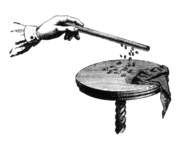Contact with the slide has left the hair positively charged
so that the individual hairs repel one another.
so that the individual hairs repel one another.
Static electricity refers to the buildup of electric charge on the surface of objects. The static charges remains on an object until they either bleed off to ground or are quickly neutralized by a discharge. Although charge exchange can happen whenever any two surfaces come into contact and separate, a static charge will only remain when at least one of the surfaces has a high resistance to electrical flow (an electrical insulator). The effects of static electricity are familiar to most people because we can see, feel and even hear the spark as the excess charge is neutralized when brought close to a large electrical conductor (for example a path to ground), or a region with an excess charge of the opposite polarity (positive or negative). The familiar phenomenon of a static 'shock' is caused by the neutralization of charge.
History
A simple demonstration using a charged rod to attract scraps of paper.
From the 1878 book Opfindelsernes Bog (Book of inventions), by André Lütken.
From the 1878 book Opfindelsernes Bog (Book of inventions), by André Lütken.
The natural phenomenon of static electricity was known at least as early as the 6th century BC, as attested by Thales of Miletus. Scientific research into the subject began when machines were built to create it artificially, such as the friction generator developed by Otto von Guericke in the 17th century. Benjamin Franklin famously demonstrated the connection between static electricity and storm clouds in 1750. In 1832, Michael Faraday published the results of his experiment on the identity of electricities, which proved that the electricity induced using a magnet, voltaic electricity produced by a battery, and static electricity were all the same. Since Faraday's result, the history of static electricity merged with the study of electricity in general.
Causes of static electricity
The materials we observe and interact with from day-to-day are formed from atoms and molecules that are electrically neutral, having an equal number of positive charges (protons, in the nucleus) and negative charges (electrons, in shells surrounding the nucleus). The phenomenon of static electricity requires a separation of positive and negative charges.
Contact-induced charge separation
Electrons can be exchanged between materials on contact; materials with weakly bound electrons tend to lose them, while materials with sparsely filled outer shells tend to gain them. This is known as the triboelectric effect and results in one material becoming positively charged and the other negatively charged. The polarity and strength of the charge on a material once they are separated depends on their relative positions in the triboelectric series. The tribo electric effect is the main cause of static electricity as observed in everyday life, and in common high-school science demonstrations involving rubbing different materials together (e.g. fur and an acrylic rod). Contact-induced charge separation causes your hair to stand up and causes static cling.
References:
- http://en.wikipedia.org
- "Franklin's Kite". http://www.mos.org/sln/toe/kite.html. Retrieved on 2008-02-19.
- Krider, E. Philip (January 2006). "Benjamin Franklin and Lightning Rods". Physics Today. http://www.physicstoday.org/vol-59/iss-1/p42.html. Retrieved on 2008-04-06.
- J. J. Lowke (1992). "Theory of electrical breakdown in air". Journal of Physics D: Applied Physics 25: 202–210. doi:10.1088/0022-3727/25/2/012. http://www.iop.org/EJ/article/0022-3727/25/2/012/jd920212.pdf?request-id=XIfZw4zI3BGDoxCz2wi7Kg.
- Kassebaum, J. H. and Kocken, R. A. (1995). "Controlling Static Electricity in Hazardous (Classified) Locations". Petroleum and Chemical Industry 42nd Annual Conference Papers: 105–113. http://ieeexplore.ieee.org/iel3/4013/11530/00523945.pdf?tp=&arnumber=523945&isnumber=11530.
- Wagner, John P.; Clavijo, Fernando Rangel [doi:10.1016/S0304-3886(00)00019-X Electrostatic charge generation during impeller mixing of used transformer oil] Department of Nuclear Engineering, Safety Engineering and Industrial Hygiene Program, Texas A&M University, College Station, online 21 August 2000; accessed Jan 2009
- Hearn, Graham (1998). "Static electricity: concern in the pharmaceutical industry?". Pharmaceutical Science & Technology Today 1 (7): 286–287. doi:10.1016/S1461-5347(98)00078-9.
- Egorov, V.N. Electrification of petroleum fuels Khimiya i Tekhnologiya Topliv i Masel, No. 4, pp. 20–25, April, 1970 accessed Dec 2008
- Chevron Corporation Aviation Fuels Technical Review 2006, accessed Dec 2008
- Hearn, Graham Static electricity - guidance for Plant Engineers - Wolfson Electrostatics University of Southampton 2002; accessed Dec 2008
- Kinzing, G.E., 'Electrostatic Effects in Pneumatic Transport: Assessment, Magnitudes and Future Direction', Journal Pipelines, 4, 95-102, 1984
- "Snopes.com: Fuelish Pleasures". http://www.snopes.com/autos/hazards/gasvapor.asp. Retrieved on 2008-04-19.
- "NASA - Crackling Planets". http://science.nasa.gov/headlines/y2005/10aug_crackling.htm. Retrieved on 2008-01-20.
- "Kids science projects". http://www.creativekidsathome.com/science/staticelectricity.html. Retrieved on 2008-01-20.
- H. Yasuro, H. Makoto and I. Isao (2007). "Charging of Adhesive Tapes on Peeling". Journal of the Adhesion Society of Japan 43 (3): 97–103. http://sciencelinks.jp/j-east/article/200706/000020070607A0223458.php.
- "3M Material Safety Data Sheet". http://multimedia.mmm.com/mws/mediawebserver?BBBBBBXeXgc1ZGXFEqZswKKgRmpBWHcbKGcByi5--. Retrieved on 2008-01-20.



